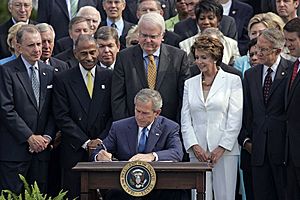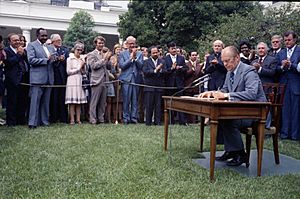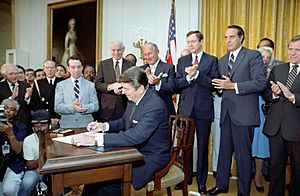Amendments to the Voting Rights Act of 1965 facts for kids
The Voting Rights Act of 1965 is a very important law in the United States. It helps protect the right to vote for all citizens, especially those who faced discrimination in the past. Over the years, Congress has made big changes to this law. These changes happened in 1970, 1975, 1982, 1992, and 2006.
Each time, these changes happened because some parts of the Act were about to end. These special rules were first meant to stop in 1970. But people realized that unfair voting practices were still happening. So, Congress kept updating the Act to keep these important rules going.
Most of these updates made the special rules last longer. For example, they were extended for 5 years in 1970, 7 years in 1975, and 25 years in 1982 and 2006. Congress also made the Act cover more areas. This happened by adding new dates that triggered the rules in 1970 and 1975. In 1975, the Act also started to protect people who spoke languages other than English. This meant places had to provide voting information in other languages if many people there spoke them.
To make it easier for areas covered by the Act, Congress changed a rule in 1982. This rule, called "bailout," allowed places to leave the special rules if they showed they protected voting rights and helped more minority groups vote.
Besides extending rules and covering more areas, Congress added other important parts to the Act. For example, the ban on unfair "tests or devices" (like tricky literacy tests) became nationwide in 1970. In 1975, this ban became permanent. Also in 1975, the Act started protecting "language minorities." This included American Indians, Asian Americans, Alaskan Natives, and people of Spanish heritage. The Act now made it illegal to discriminate against these groups when it came to voting.
Another important change was Section 203. This rule makes election officials provide ballots and voting information in other languages. This is for areas with many people who don't read English well. This rule was extended many times, lasting 25 more years in 2006. Some people think this rule is very helpful for new citizens. Others think it costs too much money.
Some changes to the Act were made because Congress disagreed with court decisions. In 1982, Congress changed Section 2 of the Act. This was to overturn a Supreme Court case called Mobile v. Bolden (1980). That case said Section 2 only stopped discrimination if it was done on purpose. Congress changed Section 2 to stop any voting practice that had a discriminatory effect, even if it wasn't on purpose. This "results test" made it easier to challenge unfair voting laws. In 2006, Congress changed the Act again to overturn two more Supreme Court cases. These changes made sure the Act continued to fight against all kinds of voting discrimination.
In 2013, the Supreme Court made a decision in Shelby County v. Holder. This decision removed a key part of the Act that decided which areas were covered by the special rules. Since then, new laws have been suggested to fix this, but they haven't passed yet.
Contents
1970 Amendments to the Voting Rights Act
 |
|
| Long title | An Act To extend the Voting Rights Act of 1965 with respect to the discriminatory use of tests, and for other purposes |
|---|---|
| Enacted by | the 91st United States Congress |
| Effective | June 22, 1970 |
| Citations | |
| Public law | 91-825 |
| Statutes at Large | 84 Stat. 314 |
| Codification | |
| Acts amended | Voting Rights Act of 1965 |
| Legislative history | |
|
|
In 1970, the special rules of the Act were about to end. Congress held many meetings to decide if the Act should be changed and continued. They saw that voting discrimination was still happening. Even though progress had been made, enough unfairness remained to keep the special rules.
President Richard Nixon's team wanted to extend the law but make it weaker. They suggested getting rid of some key parts. But the Senate disagreed and created its own bill. This bill passed easily in both the Senate and the House. President Nixon signed it into law on June 22, 1970.
This new law extended the special rules for five more years. It also made the Act cover more areas by adding new trigger dates from 1968. This helped include places outside the South. The law also made the ban on "tests or devices" apply to the whole country.
New rules were added for presidential elections. These rules made voter registration and absentee voting more uniform. They also stopped states from requiring people to live there for a long time before voting. Because of the Vietnam War, Senator Ted Kennedy helped add a rule. This rule gave 18-year-olds the right to vote in all elections. President Nixon doubted this part was legal. The Supreme Court later said 18-year-olds could vote in federal elections, but not state ones. This led to the Twenty-sixth Amendment, which lowered the voting age to 18 for all elections.
1975 Amendments to the Voting Rights Act
 |
|
| Long title | An Act to amend the Voting Rights Act of 1965 to extend certain provisions for an additional seven years, to make permanent the ban against certain prerequisites to voting, and for other purposes |
|---|---|
| Enacted by | the 94th United States Congress |
| Effective | August 6, 1975 |
| Citations | |
| Public law | 94-73 |
| Statutes at Large | 89 Stat. 400 |
| Codification | |
| Acts amended | Voting Rights Act of 1965 |
| Legislative history | |
|
|
In 1975, Congress looked at the Act again as its special rules were set to expire. This time, there was more agreement that the law was still needed. President Gerald Ford's team supported extending the Act without making it weaker. After meetings, Congress passed the changes easily. President Ford signed them into law on August 6, 1975.
The changes extended the Act's special rules for seven more years. Congress also made the nationwide ban on "tests or devices" permanent. The Act also covered more areas by adding new trigger dates from 1972.
The 1975 changes also helped minority groups who hadn't been fully protected before. Groups like Hispanic, Asian American, Native Alaskan, and Native American people said they faced voting discrimination. This was especially true where English was not the main language. Congresswoman Barbara Jordan helped lead the effort to protect these "language minorities."
The law was changed to stop rules that only allowed voting information in English. This applied to places where a single language minority group made up more than 5% of the voting-age population. This brought states like Texas under the Act's coverage. Also, new rules made election officials provide ballots and voting information in the languages of these minority groups.
1982 Amendments to the Voting Rights Act
In 1982, the special rules were again close to ending. Many civil rights groups pushed Congress to extend them and make the Act's ban on discrimination stronger.
The House of Representatives held many hearings. Most people who spoke supported extending the Act's special rules. President Ronald Reagan's team initially suggested a different approach. But after some debate, the House passed a bill to keep the current coverage rules and make the special rules permanent. The Senate eventually agreed to extend the special rules for 25 years. However, the bilingual election rule was extended for seven years.
The Senate also made it easier for covered areas to "bail out" of the special rules. A state or local government could leave coverage if it showed it had followed the Act. It also had to show it helped increase political participation for minorities for 10 years. A local government could even bail out if its state was still covered.
Congress focused most on changing Section 2 of the Act. Two years earlier, the Supreme Court had ruled in Mobile v. Bolden (1980). This case said that laws were only discriminatory if they were made with a discriminatory purpose. This meant showing a law simply had a discriminatory effect was not enough. This decision made it harder to fight voting discrimination.
Many people were upset by this court decision. During Senate meetings, the main topic was whether to change Section 2. They wanted to create a "results" test. This test would stop any voting law that had a discriminatory effect, no matter the purpose. President Reagan was worried about this change. Some members of Congress also worried it would force courts to make sure minority groups had a certain number of elected officials. To fix this, a compromise was made. It clearly stated that the "results test" would not require a certain number of elected officials for minority groups. This compromise gained wide support. The House and Senate passed the bill easily. President Reagan signed it into law on June 29, 1982. This new "results test" in Section 2 became the main way to challenge voting discrimination.
1992 Amendments to the Voting Rights Act
In 1992, the bilingual election rule in Section 203(c) was about to expire. Congress looked at extending and expanding it. Representative José E. Serrano introduced a bill to extend the rule for 15 years. This would make it end at the same time as other special rules in 2007.
The bill also expanded the bilingual election rule. It would cover areas with at least 10,000 people from any of the protected language minority groups. This included big cities like Philadelphia, San Francisco, and Los Angeles. The bill also created a special rule for Native American language-minority voters on Indian reservations. This was because reservation borders often didn't match state or county lines.
This bill faced more opposition than the 1982 changes, mostly from Republicans. Supporters said that without bilingual help, new citizens couldn't vote easily. They also said the country had a history of accepting different languages. Opponents argued that the Act wasn't meant to protect language minorities. They also said the bilingual help cost too much money. Attempts to weaken the bill failed. Congress passed the bill with mostly Democratic support. President George H. W. Bush signed it on August 26, 1992.
2006 Amendments to the Voting Rights Act
In 2006, Congress looked at the Act again because its special rules were set to expire in 2007. Civil rights groups wanted the special rules renewed and made stronger. Democrats generally supported renewing them. However, Republicans controlled Congress and the presidency. Many Republicans felt the "preclearance" rule (where some areas needed federal approval for voting changes) was unfair to states' rights.
Republicans also noticed that the Act often helped them win elections. This was because it sometimes required areas to group Democratic-leaning minority voters into fewer electoral districts. Also, a key Republican leader, Jim Sensenbrenner, strongly wanted to renew the special rules. So, there was early agreement to renew them.
In 2005, a House committee started holding meetings. Few people spoke against renewing the special rules. The committee focused on gathering proof of voting discrimination. Congress felt it needed to show that the special rules were still needed to fight discrimination. They gathered evidence like minority voter registration rates and instances of discrimination.
On May 2, 2006, Representative Sensenbrenner introduced a bill. It proposed extending the special rules for 25 years and keeping the current coverage rules. The bill also aimed to overturn two recent Supreme Court cases. These cases had made it harder to stop voting changes that hurt minority voters. While the bill was almost certain to pass, some Republicans tried to change it. They argued that the renewal unfairly targeted certain areas. Others argued that the bilingual election rules cost too much. All these attempts to change the bill failed. The House passed the bill on July 13, 2006, with strong support.
Shortly after, the Senate passed the bill unanimously on July 20, 2006. President George W. Bush signed the bill into law on July 27, 2006. This was a year before the old rules were set to expire. Many civil rights leaders and family members of Martin Luther King Jr. and Rosa Parks were there for the signing ceremony.
Proposed Amendments to the Voting Rights Act
Many ideas to change the Voting Rights Act of 1965 have been suggested but haven't passed yet. In 2013, the Supreme Court case Shelby County v. Holder removed the part of the Act that decided which areas were covered by special rules. Since then, several bills have been suggested to create a new way to decide coverage.
For example, the Voting Rights Amendments Act was introduced in 2014. It aimed to create a new coverage rule and change other parts of the Act. But no action was taken, and it expired. In 2019, Representatives Jim Sensenbrenner and John Conyers Jr. introduced another bill. This bill suggested covering 13 states with a history of voter discrimination. The House of Representatives voted for this bill in December 2019. However, President Donald Trump said he would stop it if it passed the Senate.
The For the People Act was passed by the House of Representatives in March 2021. It is now waiting for a vote in the Senate. The Senate is evenly split, and Republicans have used a tactic called the filibuster to stop the bill from being voted on.
The John Lewis Voting Rights Act is another bill that would create a new coverage rule for the Act. This is to replace the rule removed by the Shelby County decision. This bill is also waiting for a vote in the House of Representatives. It is expected to pass there, with Democrats mostly supporting it and Republicans mostly opposing it.
|




